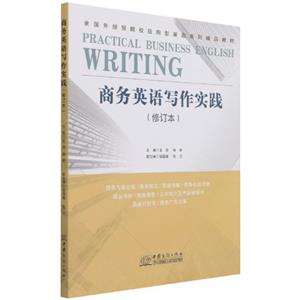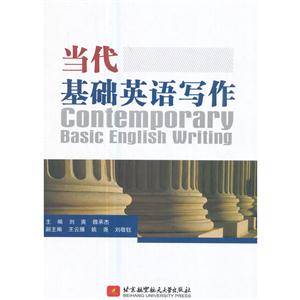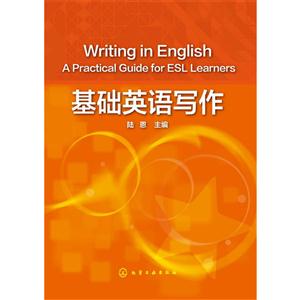
作者:王巍,王津,何晓茵主编
页数:178页
出版社:吉林大学出版社
出版日期:2018
ISBN:9787569237139
电子书格式:pdf/epub/txt
内容简介
本书八个单元, 每个单元一个逻辑结构, 前三个单元为时态、语态与人称、修饰语。第四到第八单元为因果、比较与对比、举例、条件和目的五个常用逻辑。每单元知识讲解和写作建议两部分以第一人称撰写, 尽量站在学习者角度, 采用生活化语言, 使抽象的知识点更易理解。每单元的Task部分多以句子排序开始, 训练学习者的语言通顺性。
本书特色
这本教程适合英语基础薄弱和曾有过痛苦的语言学习体验的学习者。他们可能是英语写作的初学者,也可能是独立院校和高职高专的英语专业学生。每个单元的内容以循序渐进为原则,通过培养观察习惯和书写行为带动认知,通过第一人称讲解和贴近生活实际的写作任务激发写作动机,通过范文例句的语料输入使仿写目标具体明确。既适用于课堂教学,也适用于学习者自主学习。
目录
Part One …………………………………………………………………… 002
Learning Targets ……………………………………………………… 002
How to Develop a Paragraph or an Essay by Time ………………… 002
Part Two Multiple Tasks ………………………………………………… 005
Task One ……………………………………………………………… 005
Task Two ……………………………………………………………… 006
Task Three …………………………………………………………… 010
Task Four …………………………………………………………… 012
Part Three Writing Tips …………………………………………………… 019
What Does an Effective Sentence Look Like? ……………………… 019
Unit Two Voice and Person/Point of View …………………… 021
Part One …………………………………………………………………… 022
Learning Targets ……………………………………………………… 022
What Is Passive Voice? ……………………………………………… 022
What Is Person or Point of View? …………………………………… 024
Part Two Multiple Tasks ………………………………………………… 026
Task One ……………………………………………………………… 026
Task Two ……………………………………………………………… 030
Task Three …………………………………………………………… 032
Task Four …………………………………………………………… 036
Part Three Writing Tips …………………………………………………… 039
What Does an Effective Paragraph Look Like? ……………………… 039
Unit Three Modification ……………………………………… 041
Part One …………………………………………………………………… 042
Learning Targets ……………………………………………………… 042
How to Correctly Use Modifiers ……………………………………… 042
Part Two Multiple Tasks ………………………………………………… 044
Task One ……………………………………………………………… 044
Task Two ……………………………………………………………… 047
Task Three …………………………………………………………… 048
Task Four …………………………………………………………… 050
Part Three Writing Tips …………………………………………………… 053
What Does an Effective Essay Look Like? ………………………… 053
Unit Four Cause and Effect ………………………………… 055
Part One …………………………………………………………………… 056
Learning Targets ……………………………………………………… 056
How to Develop a Paragraph or an Essay by Cause and Effect ……… 056
Part Two Multiple Tasks ………………………………………………… 058
Task One ……………………………………………………………… 058
Task Two ……………………………………………………………… 061
Task Three …………………………………………………………… 064
Task Four …………………………………………………………… 065
Part Three Writing Tips …………………………………………………… 070
What Is a Thesis and How Can We Write a Thesis Statement? ……… 070
Unit Five Comparison and Contrast ………………………… 073
Part One …………………………………………………………………… 074
Learning Targets ……………………………………………………… 074
How to Compare and Contrast ……………………………………… 074
Part Two Multiple Tasks ………………………………………………… 076
Task One ……………………………………………………………… 076
Task Two ……………………………………………………………… 079
Task Three …………………………………………………………… 082
Task Four …………………………………………………………… 085
Part Three Writing Tips …………………………………………………… 090
How Can We Work out an Outline? ………………………………… 090
Unit Six Illustration …………………………………………… 093
Part One …………………………………………………………………… 094
Learning Targets ……………………………………………………… 094
How to Write Supporting Details …………………………………… 094
Part Two Multiple Tasks ………………………………………………… 101
Task One ……………………………………………………………… 101
Task Two ……………………………………………………………… 102
Task Three …………………………………………………………… 104
Task Four …………………………………………………………… 106
Part Three Writing Tips …………………………………………………… 109
What Does a Good Beginning Look Like? ………………………… 109
Unit Seven Condition ………………………………………… 111
Part One …………………………………………………………………… 112
Learning Targets ……………………………………………………… 112
How to Use Condition Clause and Subjunctive Mood ……………… 112
Part Two Multiple Tasks ………………………………………………… 115
Task One ……………………………………………………………… 115
Task Two ……………………………………………………………… 117
Task Three …………………………………………………………… 119
Task Four …………………………………………………………… 121
Part Three Writing Tips …………………………………………………… 124
How Can We Write a Body Part? …………………………………… 124
Unit Eight Purpose …………………………………………… 125
Part One …………………………………………………………………… 126
Learning Targets ……………………………………………………… 126
How to Write a Purpose ……………………………………………… 126
Part Two Multiple Tasks ………………………………………………… 128
Task One ……………………………………………………………… 128
Task Two ……………………………………………………………… 131
Task Three …………………………………………………………… 136
Part Three Writing Tips …………………………………………………… 139
What Does an Effective Conclusion Look Like? …………………… 139
Answers ………………………………………………………… 140
References ……………………………………………………… 178
节选
Unit One Tense
Part One
Learning Targets
1. Use some structures.
a. not… until…
b. …before…
c. succeed in doing sth.
d. make+sb./sth.+do; make+sth.+sth.
e. have+sth.+to do; have+sth.+done
2. Learn to use proper tenses according to time condition.
3. Get to know the features of narration and learn to write a narration.
4. Learn to develop paragraphs and essays by time.
How to Develop a Paragraph or an Essay by Time
We like reading stories and listening to storytelling since childhood. As growing up, we more and more frequently tell our own stories or recount events. For example, we may tell our parents or friends what has happened to us these days or share with them a very exciting or sometimes an embarrassing, frustrating or even annoying experience of our own for their sympathy.
Sometimes we have to introduce our life experience in written form especially when we are applying for a desired opportunity for further study or a better position in career. Sometimes we need describe the experience of another person or introduce the development of an organization to provide information.
The best strategy for us to do these is to describe things in order of time.
Basically, there’s no difference between languages in this way. But in some languages including English, we have to use proper forms of tense for verbs according to time condition. This is not what we do in our mother tongue; therefore it can be a challenge for us to detect time conditions and choose a correct tense accordingly.
Things we talk about have their general chronological background.
That is to say, they may be in the past, at present or in the future. Meanwhile, any time condition has its own unique form. Besides a general time condition as yesterday, today or tomorrow, it can be an exact time, such as “19:30 last Saturday”, “8 o’clock in the morning”, or “3 p.m. tomorrow”. Or it can be a period of time, such as 5 minutes or 5 centuries. And time signals can be phrases like “every weekend”, “at eight”, “for two years” or “by next Monday”. They can also be subordinate clauses like “when my mum called me yesterday” or “before they have finished the task.” Furthermore, every verb or action has its own state under a certain time condition. We choose a continuous tense for an exact time and a perfect tense for a period, whether in the past, at present or in the future. We can show how we find the relationship between time signals and proper tenses in the following Table 1.
From the table above, we can read the basic nine tenses by matching the left with the right one by one. In order to correctly describe things, we ought to be conscious of the tense we use in every sentence. Particularly, a strong sense of tense must be shown in a narration, whether it is in speaking or in writing, which is usually developed in order of time.
Narration is a genre for us to tell a story in order to inform or entertain.
At the beginning, we usually provide some information of the story including when, where, who and its cause. Then we present some following details chronologically. When it comes to the ending, we sometimes make clear our purpose of telling the story. More often, we leave it to our readers to figure out themselves.
In the given samples in this unit, we can see how those authors develop their paragraphs or essays by time and how well they use tense.















